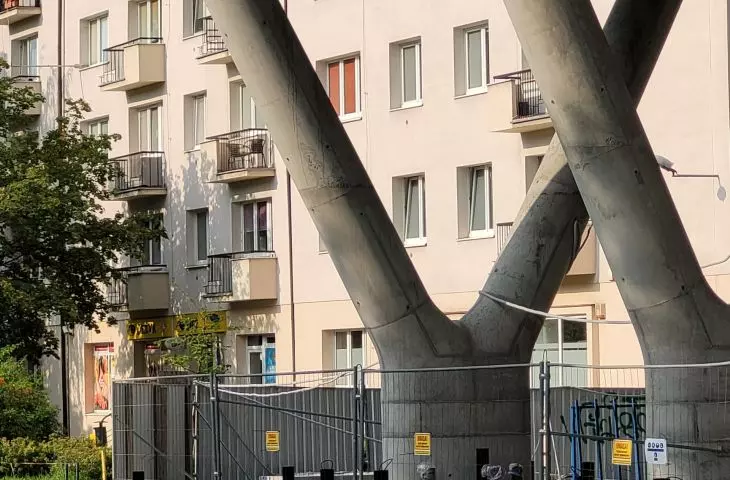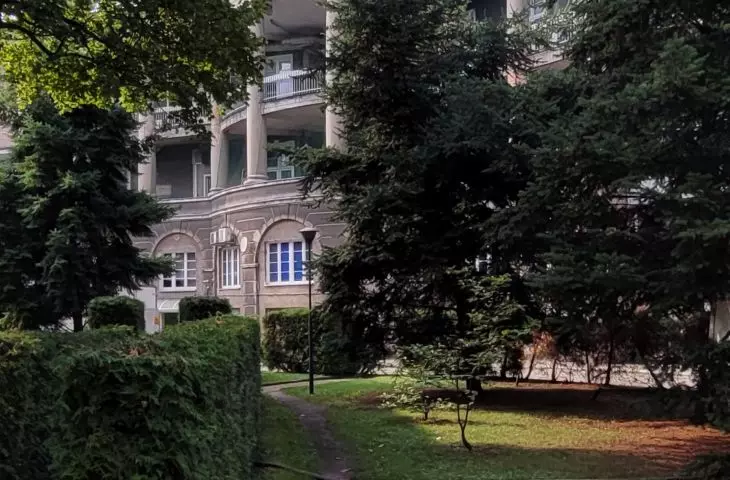The new wing of the Wielkopolska Oncology Center in Poznań is almost ready. The lump on distinctive cantilevers has „slipped” into the cramped neighboring buildings. Meanwhile, the WOC is planning further investments and absorbing the buildings after the neighboring clinical hospital.
The Wielkopolska Oncology Center is the only hospital in Poznań that is expanding in the city center and ties its future to it. It now occupies several buildings between Garbary and Strzelecka streets, on the outskirts of the Old Town, on the site where Hipolit Cegielski's first factory stood in the 19th century (his restored cantor still exists on the premises of the hospital).
Wielkopolska Oncology Center, Poznań, Garbary Street, from left: radiotherapy facility, main building from the 1970s and 1980s,
the oldest hospital building, in perspective—the towers of the Bernardine Church
Photo: Jakub Głaz
The oncology hospital has been operating on Garbary Street since 1953 (under its current name since 1990). It was expanded both in the 1970s and 1980s and after 2000. The first decades of this century saw the construction of a tall building for the Central Operating Suite and a winter garden(Pracownia Architektoniczna Ewa i Stanisława Sipińscy, real.: 2006), a low pavilion for the Radiotherapy Department (2009) and a four-story building along Garbary Street (designed by Janusz Wyżnikiewicz, real.: 2013).
Wielkopolska Oncology Center, Poznań, Garbary Street (view from the north)—four-story wing from 2013 (designed by Janusz Wyżnikiewicz), with the building from the 1970s and 1980s in the background.
photo: Jakub Głaz
tight and diverse
Each expansion required fitting into a difficult urban context. From the east, the hospital complex borders Garbary Street—a busy and narrow transit route through the Old Town. From the north, the clinic borders the historic buildings of the University Clinical Hospital on Dluga Street (until 2021—named after the Transfiguration of the Lord). To the south and west, it adjoins a complex of interwar townhouses and several residential additions from the communist era. So it's very cramped here, and the buildings of the two hospitals have very different metrics, forms and dimensions. The spaces between them are quite chaotic and unfriendly.
Wielkopolska Oncology Center, Poznań, Garbary Street,
View of the WOC Central Operating Block from the area of the clinical hospital on Dluga Street.
Photo: Jakub Głaz
The newest wing of the WOC was connected directly to the Central Operating Block and occupied the last, almost entirely vacant area, reaching Strzelecka Street. It now serves as a strong new accent on its eastern frontage, replacing a much smaller 1933 villa demolished for the hospital's expansion (deleted from the Register of Historic Places in 2016). The distinctive massing with a spacious arcade on four concrete supports is the realization of a design by Warsaw-based CAD Architecture Studio. It was selected in an architectural competition held by the Poznań SARP in 2018.
The new wing of the Wielkopolska Oncology Center, Poznań, Strzelecka Street,
view from the west, in the background—connection to the Central Operating Block; proj. CAD Authors' Architecture Studio
photo: Jakub Głaz
second and expressive
The capital's CAD architects, however, then took second place. The main trophy was awarded to the Bydgoszcz-Warsaw design team: Karol Anioła, Konrad Garbowski and Tomasz Skalski.
SARP competition for the new wing of the WOC in Poznań, 2018,
First prize, arch: Karol Anioła, Konrad Garbowski, Tomasz Skalski
source: Poznań.sarp.pl
However, in the course of post-competition negotiations, a contract was not signed, and a decision was made to realize another work from the podium, where—in addition to the aforementioned designers—the Poznań studio Front Architects (third place) stood.
SARP competition for the new wing of the WOC in Poznań, 2018—third place, proj. Front Architects.
© Front Architects, source: Poznań.sarp.pl
This is how the most expressive design was realized, which loosely refers to both pre-war modernism (streamline curves, horizontal ribbons of windows) and a motif from the first post-war decades in the form of V-shaped supports. The massiveness of the forms used, their juxtaposition and finishing materials, however, clearly indicate the building's contemporary pedigree.
The new wing of the Wielkopolska Oncology Center, Poznań, Strzelecka St,
view from the south, designed by CAD Authors' Architecture Studio
photo: Jakub Glaz
At the same time, it is worth noting that the lighter and more discreet designs from the first and third places were somewhat more aptly related to the modernist surroundings. In turn, the competition court reported that the second prize:
was awarded for strongly emphasizing its presence in the frontage of Strzelecka Street with its form and mass. Despite its modern and technological expression, the building fits into the dimensions of the surrounding buildings [...]. Correctly solved communication services and connections on individual floors connecting the designed part with the existing complex.
At the same time, the judges had reservations about the arrangement of some functions and the slightly exceeded allowable building area.
SARP competition for the new wing of the WOC in Poznań, 2018—2nd place, Autorska Pracownia Architektury CAD, competition board.
© Autorska Pracownia Architektury CAD, source: Poznań.sarp.pl
no night stays
So what functions will the new wing serve? All hospital outpatient clinics will be moved here, and an outpatient clinic will be created for patients who do not require 24-hour stays. There is also an emergency room, chemotherapy stations, an underground garage, and a roof terrace. Completion has slipped slightly, as work was originally scheduled to be completed as early as May, but it is likely that the opening will take place in the coming months.
However, this is not the end of plans to expand an important medical facility. In January of this year, the Wielkopolska Marshal's Office acquired a plot of land for the WOC after former garages and warehouses on the east side of Garbary Street, at the junction with St. Maria Magdalena Street. A three-unit facility for treatment and diagnostics, rehabilitation and psychological care is to be built there in the coming years. It will be connected to the main, complex across the street by an underground tunnel.
The site for the expansion of the WOC on St. Maria Magdalena Street; view from the south
photo: Jakub Głaz
The plans also still include a hostel and a multi-level parking lot (access to the WOC and parking have been a big problem for years). During a January meeting of the Parliamentary Group for the Development of the Wielkopolska Oncology Center, the WOC showed two other sites for expansion—to be realized in the second half of this decade. The first is an apartment building with a plot of land next to the radiotherapy facility, and the second is a vacant parcel of land on neighboring Kazimierza Wielkiego Street.
Wielkopolska Oncology Center, Poznań, Garbary Street,
An expressive shed next to the Radiotherapy Department, in the background the greenery of the yard of the neighboring building, which the WOC would like to develop
photo: Jakub Głaz
transforming to transform
Finally, the WOC wants to occupy the buildings of the aforementioned clinical hospital on Dluga Street. Its departments operating here are to move around 2026 to the new facilities of the Integrated Clinical Hospital under construction on Przybyszewskiego Street. Thus, in June of this year, the Center signed a letter of intent with the Congregation of the Sisters of Charity of St. Vincent de Paulo, which owns the buildings on Długa Street.
University Clinical Hospital on Dluga Street in Poznań general view from the northwest,
in the background: the tower of the former monastery temple and the towers of the Bernardine Church at Plac Bernardyński
Photo: Jakub Głaz
The oncologists would rent and restore historic buildings and demolish some of the newer, but non-functional buildings. In this way, the WOC would gain more space and a spacious green courtyard. At the same time, the hospital function of the place, where treatment and care of the sick has been carried out for two centuries, will be maintained.
University Clinical Hospital on Długa Street in Poznań
Entrance from Długa Street, visible rotunda with dome in the building from the interwar years (northern elevation)
photo: Jakub Glaz
So there is a chance that the diverse architecture of the clinical complex, which includes the former Bernardian convent (the oldest part from the 16th century), 19th-century buildings and the spectacular main edifice with the domed rotunda of the lecture hall dominating it and a spacious two-story loggia (designed by Edward Madurowicz, Julian Puterman, Lucjan Wejchert, 1925-32), will regain its luster.
University Clinical Hospital on Dluga Street in Poznań,
green courtyard on the south side of the building from the interwar years
photo: Jakub Głaz
Perhaps preserving the medical function will turn out to be the best way to save the historic and heavily used building. Unlike what happened to the former Municipal Hospital on Szkolna Street, whose partially demolished and abandoned walls now haunt just off the Old Market Square.





































































